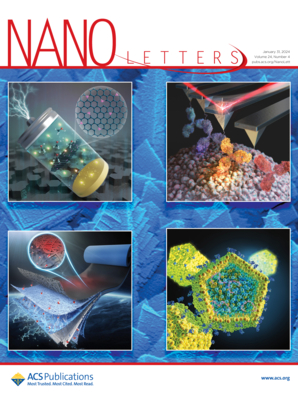二维半导体异质结的门可调谐热电子萃取
IF 9.6
1区 材料科学
Q1 CHEMISTRY, MULTIDISCIPLINARY
引用次数: 0
摘要
热载流子太阳能电池(HCSCs)可以收集带隙以上光激发产生的热载流子的多余能量,对于将太阳能电池效率提高到Shockley-Queisser极限之外至关重要,这主要是由于热载流子的快速冷却而难以实现。通过在MoSe2/hBN/WS2结中执行瞬态反射光谱,我们证明了从MoSe2到WS2的热电子的栅极可调谐收获。通过光谱区分晶格温度升高和热电子萃取,我们发现在MoSe2中静电掺杂电子可以将热电子萃取密度(nET)提高几十倍。这种增强来自于热激子与掺杂电子之间的相互作用,将热激子的多余能量转化为费米海的激发,从而产生热电子。此外,通过外加电场减小导带偏置可以进一步增强nET。我们的研究结果为静电策略设计HCSCs提供了深入的见解。本文章由计算机程序翻译,如有差异,请以英文原文为准。

Gate-Tunable Hot Electron Extraction in a Two-Dimensional Semiconductor Heterojunction
Hot carrier solar cells (HCSCs), harvesting the excess energy of hot carriers generated by above-band gap photoexcitation, are crucial for pushing the solar cell efficiency beyond the Shockley–Queisser limit, which is challenging to realize mainly due to fast hot-carrier cooling. By performing transient reflectance spectroscopy in a MoSe2/hBN/WS2 junction, we demonstrate the gate-tunable harvest of hot electrons from MoSe2 to WS2. By spectrally distinguishing hot-electron extraction from lattice temperature increase, we find that electrostatically doped electrons in MoSe2 can boost hot-electron extraction density (nET) by a factor up to several tens. Such enhancement arises from the interaction between hot excitons and doped electrons, which converts the excess energy of hot excitons to excitations of the Fermi sea and hence generates hot electrons. Moreover, nET can be further enhanced by reducing the conduction band offset with an external electric field. Our results provide in-depth insights into the design of HCSCs with electrostatic strategies.
求助全文
通过发布文献求助,成功后即可免费获取论文全文。
去求助
来源期刊

Nano Letters
工程技术-材料科学:综合
CiteScore
16.80
自引率
2.80%
发文量
1182
审稿时长
1.4 months
期刊介绍:
Nano Letters serves as a dynamic platform for promptly disseminating original results in fundamental, applied, and emerging research across all facets of nanoscience and nanotechnology. A pivotal criterion for inclusion within Nano Letters is the convergence of at least two different areas or disciplines, ensuring a rich interdisciplinary scope. The journal is dedicated to fostering exploration in diverse areas, including:
- Experimental and theoretical findings on physical, chemical, and biological phenomena at the nanoscale
- Synthesis, characterization, and processing of organic, inorganic, polymer, and hybrid nanomaterials through physical, chemical, and biological methodologies
- Modeling and simulation of synthetic, assembly, and interaction processes
- Realization of integrated nanostructures and nano-engineered devices exhibiting advanced performance
- Applications of nanoscale materials in living and environmental systems
Nano Letters is committed to advancing and showcasing groundbreaking research that intersects various domains, fostering innovation and collaboration in the ever-evolving field of nanoscience and nanotechnology.
 求助内容:
求助内容: 应助结果提醒方式:
应助结果提醒方式:


